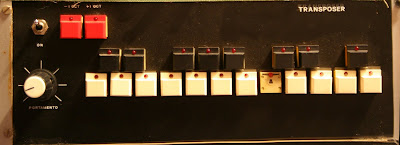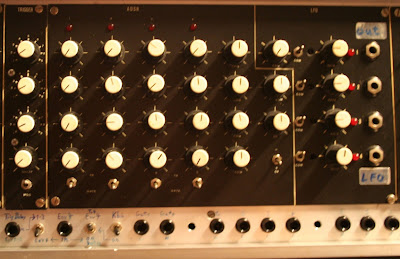
via
this auction
details in Googlish:
"Music computer system. Historically, to document the development of the former German Synthi-scene, this is a very important and unique exhibit. It probably dates from the time of the Berlin School synth in the 70s.

Here was a complete music system in a professional Flightcase to a transportation unit, consisting of
1. Level:
modular synthesizer unit
The special synthesizer module in the upper part of the set:
This elaborate special Anferigung duo consists of a digital generator
with exact half-way voice and several envelope-formers such as filters.
These are the underlying Mr.LAB-linking system.

2. Level:
MR.LAB
computer sequencer unit.

3. Level:
RHYTHM LAB
Trans Poser
a drum sequencer trigger unit.
Right there is a button for immediate octave transpositions of
top generator unit, linked with the MR.LAB.

4. Level:
FC350 (RhythmLab extension of the individual outputs)
Cassette interface
In the bottom row left the digital DRUM module FRIENDSHIP.
It is with the RHYTHM LAB-driven and has individual outputs,
and a stereo-OUT with mixed field.
Right there is a cassette recorder for the UP / DOWN-LOAD the Trig / Tone data.

The Rhythm Lab Friend Chip first came to one device on the market, on the one hand the functions of traditional rhythm and other devices offered the old desire fulfilled, even rhythms freely invent them.

You could also still usual 32 programs and select any combination. There are Drumpart and percussion (both 12 cycles) separate presets, so that here a variety of combinations available. Over a foot switch or through a break-probe 1 may also 8 bars breaks are retrieved.
The computer now allows 32 bars free program. For rapid work to copy a preset to the "Bar On Program" to him after his own tastes change.
With another break switch 2 may break sequences are retrieved, breaks with as many bars in the sequence as they occur in music pieces, strung together.
Modern technology offers not only an imitation of the toms, bass drum, etc. but also shares the metallic sound of snare drum and cymbals.
In addition to the stereo out, there is a clock-out for synchronization with sequencers.
As an optional modification, a cassette interface offered to prepared programs on tape to store and quickly retrieve, and an extension with individual outputs for each instrument and the possibility of the amplitudes separately regulated. This is here with us.
Mr.Lab was a computer sequence of the new generation, in which one up to 2048 tones could save (in the 16th represents udn Triplets The 64 bars), and at a range of 4 octaves and individual design for each tone (filter, loudness, Sustain). A novel computer-linked keyboard melody and rhythm input. With only musical instruments (any programmer working with numerical codes deleted) Mr.Lab offers a previously unheard clarity and flexibility. This new approach then, and the extensive Composer software Mr.Lab recommended not only for quick, creative work in the studio and trouble-free use in life performances, but also as a composition, arrangement and notation help.
Rhythm: 2048 Steps, with three voltages, program, and four Gate Trigger! Input clock for clock the chip by Friend developed rhythm keyboard, any Tonlängen, triplets, all types of stroke, continuously variable, optical acoustic monitor
melody: four octaves, input directly playable on Melody keyboard, a visual indicator in the keys assigned to the rhythm is displayed, fast, smooth Correct LOUDNESS, filter, sustain: to be assigned to the displayed tone, dynamics, accents, accurate Tonlängen, optical monitor, continuously variable multi-trigger: four from the melody tracks are independent trigger for controlling an electronic drum, etc. available, 64 free programmable cycles
tempo: digitally adjustable, four-digit display, seconds to milliseconds
At the Trans Poser, I can actually say very little, except that a button is missing a button. He has a 20-key keyboard (quasi 1 1 / 2 octaves), as well as octave up / down. Interesting find here the Porta Mentor Egler, possibly to Transpose to perform smoothly.
The cassette device appears at first glance a little suspect, so far it seems from a hi-fi unit seems to come, but if it's because its purpose ...
About modular synthesizer unit I could find no information, whether by friend-chip comes from. The push-button recall. It is a modular system consisting of 2 VCOs, PWM, VCF, VCA, Trigger, ADSR and LFO that has a separate bar with standard jacks patched."
 via this auction
via this auction















 via this auction
via this auction















 Here was a complete music system in a professional Flightcase to a transportation unit, consisting of
Here was a complete music system in a professional Flightcase to a transportation unit, consisting of 2. Level:
2. Level: 3. Level:
3. Level: 4. Level:
4. Level: The Rhythm Lab Friend Chip first came to one device on the market, on the one hand the functions of traditional rhythm and other devices offered the old desire fulfilled, even rhythms freely invent them.
The Rhythm Lab Friend Chip first came to one device on the market, on the one hand the functions of traditional rhythm and other devices offered the old desire fulfilled, even rhythms freely invent them. You could also still usual 32 programs and select any combination. There are Drumpart and percussion (both 12 cycles) separate presets, so that here a variety of combinations available. Over a foot switch or through a break-probe 1 may also 8 bars breaks are retrieved.
You could also still usual 32 programs and select any combination. There are Drumpart and percussion (both 12 cycles) separate presets, so that here a variety of combinations available. Over a foot switch or through a break-probe 1 may also 8 bars breaks are retrieved.











